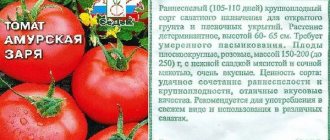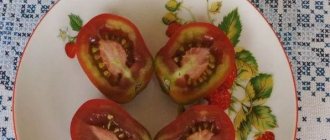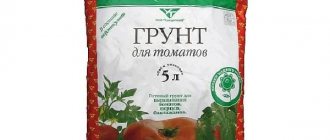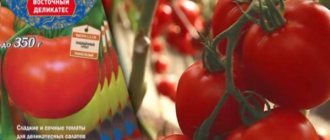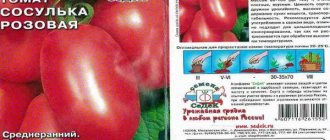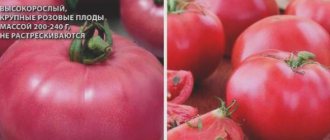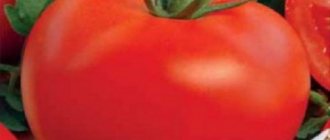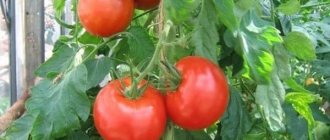Description of the tomato Bell and growing strong seedlings
Many gardeners are interested in how to grow Bell tomato? In Russia, varieties that are extremely easy to care for are popular, so they can be grown in regions with cold climates. One of these varieties is Bell. It is recommended to plant it even in the Siberian region. It belongs to the mid-season varieties; the first harvest from the bush can be harvested 4 months after sowing the seeds in containers.
What is a Bell tomato?
The Bell variety is an indeterminate variety and is suitable for growing in greenhouse conditions. Tomatoes can also be grown in open ground, but temporary shelter will be necessary. The fruits have a fleshy pulp structure that contains a small amount of seeds. Reviews from buyers and farmers who grow this variety indicate that Bell has a good taste and can easily be transported over distances.
Usually the Bell tomato bush reaches a height of 1.5 m. The first inflorescence appears above the 7th, 8th or 9th leaf. The remaining inflorescences are laid in increments of 3 leaves. Each inflorescence can bring the farmer 7-9 ripe fruits. Tomatoes are characterized by a rich red color; the shape of the tomatoes is elongated, slightly pointed at the bottom.
The weight of 1 fruit varies between 150-200 g, however, individual tomatoes reach 350 g. Such tomatoes are widely used in cooking: fresh, in various salads, for making sauces and juice. In addition, Bluebell is suitable for canning due to the structure of the skin.
The description of the variety can be reduced to several basic parameters:
- Red color;
- obtaining the first harvest in 4 months;
- average weight 150-200 g;
- grown in closed greenhouses or under a canopy;
- can be used in any culinary dishes.
How to grow tomatoes?
It is recommended to sow Bluebell tomato seeds in separate containers several months before the planned planting in the ground, the ideal time is 50-60 days before planting in a permanent place. During seed germination, it is advisable to maintain a constant temperature at +24...+25 °C.
Landing Features
There are no peculiarities in the planting of the Bluebell. In this case, the same factors are taken into account as when planting other varieties: correct timing, suitable location, preparation of soil and seedlings.
Deadlines
The time for planting raspberry seedlings is autumn, a month before the start of frost, and spring - April. However, it is necessary to take into account the climatic conditions in the region.
For example, in the southern regions, autumn planting is preferable, because spring can be early and hot, and in the fall the plants have time to take root before the onset of frost.
In areas with early autumn frosts, it is better not to risk autumn planting. Seedlings planted in the spring will take root well and strengthen, survive the winter well and produce an excellent harvest next year.
Also find out in what season it is better to replant raspberry bushes to a new location.
Choosing a suitable location
The health of the raspberry tree, the timeliness of flowering and fruiting, as well as the quality and quantity of the harvest depend on how successfully the site for the raspberry tree is selected.
The place is suitable for planting if:
- illuminated by the sun from all sides, not even partially shaded by a building wall, fence or trees;
- protected from drafts;
- does not have close-lying groundwater - no higher than 1.5 m;
- Rain and melt water do not stagnate;
- the soil is fertile and loose, with neutral acidity;
- the predecessor is not raspberries.
The selected area for raspberries needs to be prepared:
- clear of weeds;
- add organic matter (humus or compost);
- dig up.
Selection and preparation of planting material
The best way to get high-quality planting material is to divide the raspberry bush, and the easiest way is to dig up the root suckers.
Check out
What to plant after raspberries in an area in open ground: crop rotation Bluebell produces a lot of root shoots, from which you need to select the strongest sprouts, dig them up, carefully separating them from the mother root, and immediately plant them in a permanent place. If there is not yet a single Bluebell bush at your dacha from which you could take sprouts, you need to buy them
To purchase, it is better to contact a fruit and berry nursery. This way you can be sure of the purity of the variety.
If there is not yet a single Bluebell bush at your dacha from which you could take sprouts, you need to buy them. To purchase, it is better to contact a fruit and berry nursery. This way you can be sure of the purity of the variety.
When choosing seedlings, you should pay attention to the following signs:
- the roots are powerful, fibrous, branched, elastic, moist, without damage or rotten spots;
- the presence of 2–5 stems and 3 buds at the base.
The best option is seedlings with a closed root system, in containers. They take root 100%, grow faster and bring a bountiful harvest.
Landing algorithm
The bell is planted in the same way as other varieties:
- Dig holes 40x40 cm according to the number of seedlings or trenches, if there are many of them, 40 cm deep and wide. Planting pattern: 1–1.5 m between plants and 2–2.5 m between rows.
- Mix the excavated soil with fertilizers: humus (if not added during digging), wood ash, superphosphate and potassium sulfate.
- Fill the holes halfway with fertilized soil.
- Distribute the seedlings in the holes, straightening their roots. If the root system is closed, then the plants are replanted using the transshipment method along with a lump of earth.
- Cover with soil, compacting with your hands. The root collar should be above ground level.
- Water each bush generously and cover with mulch (peat, sawdust or straw).
Important! If you dig pieces of slate around the perimeter of the recess, this will prevent the spread of growth and thickening of the raspberry bush. Planting a bush in a trench looks like this:
Planting a bush in a trench looks like this:
Tomato Tsar Bell: photo and description, reviews, variety yield
“Tsar Bell” is one of the priority tomato varieties of Russian selection. It is famous for its extraordinary large-fruited size, as well as its ease of care and early ripening of delicious, selected tomatoes.
Characteristics of the variety
Tsar Bell has an average ripening time, which is 100-110 days from the moment the seeds are sowed for seedlings. Usually, with the correct growing technique, gardeners begin to feast on sweet, aromatic fruits already in July.
This variety is characterized by a determinate type of bush, that is, the plant itself stops growing after the formation of all flower clusters. The plants grow short, compact, up to one meter high (in a greenhouse the bush can stretch up to 1.5 meters).
The large, strong stem is covered with 7-9 flower clusters with large, dark green, simple-shaped leaves. The first ovary is formed above the ninth leaf, the next ones - after 1-2 leaves. The fruits are formed 4 pieces per cluster.
Since the bush grows powerful and each cluster holds several heavy fruits, it is recommended to use supports and a garter (in some cases, each cluster is tied). For a better harvest, it is recommended to form the plant into two stems.
The main distinguishing feature of the variety is the giant heart-shaped fruits, which weigh 800 grams (the average is 400-600 grams). Tomatoes are characterized by a bright red color (sometimes with a crimson tint) with a dense, smooth skin and a fleshy interior. Tomatoes have both a sweetish tint and sourness, but in moderation.
Tsar Bell is a salad type of tomato. It goes well for slicing, as well as for preparing second courses. But these tomatoes exhibit their taste best when fresh. But for canning it is better to use other varieties.
The yield of the variety is average. Usually about 8-9 kilograms are collected from one square meter. However, with increasing doses of fertilizers, the yield can increase by 1.5-2 times.
Tomatoes ripen quickly after being picked and do not crack or get soggy. They do not lose their appearance during long-term transportation, and are also stored for a long time.
- large-fruited;
- fruits are stored for a long time;
- easy to care for;
- withstands temperature changes;
- tomatoes do not lose their excellent appearance during transportation;
- is immune to major diseases.
Features of cultivation
Tsar Bell tomatoes are grown through seedlings, which can be planted both in open ground and in a greenhouse. You need to sow the seeds at the end of March or early April.
Before planting, seeds are usually soaked in a disinfectant composition and sprayed with a growth stimulant. Before planting the seeds in the soil, they are placed in warm, damp fabric material for a couple of days. During this time, the seeds will swell, and after planting in the ground, sprouts will appear very quickly, within 3-4 days.
Care during the seedling period:
- The air temperature should be 22-25 degrees Celsius during the day and 15 degrees at night.
- Seedlings should be illuminated for at least 16 hours a day.
- The soil should always be semi-moist.
- To prevent the seedlings from rotting, it is necessary to carry out periodic ventilation, avoiding cold air currents.
- Young seedlings need to be watered by sprinkling. The water should only be warm and settled.
As soon as two leaves appear on the bushes, the seedlings are picked, that is, planted in separate containers. If the plants are wilted and look sickly, the soil is fertilized with Kornerost.
Planting in open ground
A couple of weeks before transplanting tomatoes into the garden, the seedlings begin to be hardened so that they can withstand transportation painlessly. To do this, the bushes are taken out onto the veranda and kept there for an hour at first, then the time is increased. And in the last two days, the seedlings can even be put outside for the whole day.
Planting is usually done in May, when warm, dry weather sets in outside and the soil warms up to a depth of 8-10 centimeters. By this moment, the bushes will have time to grow up to 30 centimeters in height, and at least 7-9 leaves will appear on them and flower ovaries will even begin to form.
The soil for tomatoes has been prepared since autumn. When digging, add organic matter (but not fresh manure), as well as nitrogen and phosphorus-potassium fertilizers.
The bed for tomatoes is planted in two rows, with 50-60 centimeters left between them. Water is generously poured into the prepared hole, and the ground is sprinkled with ash and complex fertilizer. Before planting, 2-3 lower leaves are removed from the plant so that no shadow is formed under the bush. It is better to plant by transshipment, removing the bush from the container along with a lump of earth. This way, the likelihood of injury to the fragile rhizome will decrease significantly. After planting, the bush is covered with earth and then watered again.
Description of the tomato variety Bell, recommendations for cultivation and care
When choosing varieties to obtain dense fruits, you should definitely pay attention to the Bell tomato. Plants of this species are high-yielding and tolerant of adverse weather conditions.
Description
Mid-early determinate variety. The height of the bush is 50–60 cm. The leaves are small, light green. The plant is medium leafy. Since during the fruiting period a large number of fruits are set on the plant, it is recommended to tie the stems. When using supports, the risk of damage is minimal.
The fruits are shaped like a pear with an elongated sharp tip . The clusters consist of 6–7 fruits weighing 50–60 g. Ripe fruits are colored pink-scarlet. The fruits are used for preparing salads, canned whole fruits and decorating dishes.
The core is juicy and dense. There are few seed chambers. The tomatoes taste sweet with barely noticeable sourness. Thanks to the strong skin, the fruits are resistant to cracking, tolerate long-term transportation and are stored for a long time.
The variety is intended for cultivation in open ground. In case of rainy or cold summers, tomatoes are grown in a greenhouse.
Bluebell tomatoes have the following benefits:
- versatility of fruits;
- original form;
- do not require any special care;
- tolerant of temperature fluctuations;
- has high immunity to most tomato diseases.
For abundant fruiting, the plant needs to be provided with nutritious soil and planting.
Features of cultivation and care
To obtain tomato seedlings, seeds are sown after May 15 in containers filled with loose substrate. To create a greenhouse effect, the container is covered on top with a piece of glass or film. After the seedlings emerge, the shelter is removed, the box is placed in a lighted place and the temperature is reduced by several degrees. In a cool environment, the sprouts do not stretch.
Subsequent care for tomatoes includes the following manipulations:
- Watering. Tomatoes are one of those crops that suffer from high humidity. To prevent the development of fungal diseases, plants are watered abundantly, but rarely. If the summer is dry, the bushes are watered once a week. Water consumption per adult plant is 3–4 liters. After each watering or heavy rain, the soil is loosened and the bushes are lightly hilled.
- Dive. Plants are transplanted from a large container into separate pots at the age of 2-3 true leaves, and to a permanent place - after the formation of 5 leaves.
- Stepsonning and garter. The best scheme for growing a high-yielding variety is considered to be the formation of one or two stems. In the first case, all lateral shoots are removed, in the second, two stems are left. To prevent the plant from getting sick, the stepsons are removed gradually. Tie the plants to metal or wooden stakes immediately after they take root in a permanent place.
- Feeding. During the first period of development, tomatoes are fed with organic or mineral fertilizers with a balanced amount of nitrogen, phosphorus and potassium. After the plants enter the flowering and fruiting phase, only mixtures are added, which consist mainly of potassium and phosphorus. Feeding is carried out at intervals of 2 weeks.
How to grow tomatoes
Seedlings are planted in a permanent place of growth no earlier than the end of May - beginning of June.
Hypothermia of the root system will reduce the yield, so the plants are transplanted into well-warmed soil of 8-10 cm. The crop is demanding on lighting, so tomatoes are placed in a well-lit area away from buildings and trees. The bed is prepared in the fall: it is cleared of weeds and remains of cultivated plants, then the soil is sprinkled with humus and dug up.
Landing
When the plants grow to 30 cm, they are transplanted into open ground or a greenhouse. By this time, the bushes will have 6-7 leaves and will bloom. Before planting, 3 lower leaves are removed from the plants to provide the tomatoes with good lighting.
Good predecessors for tomatoes are cabbage, cucumbers, melons, root vegetables, and green manure. Tomatoes are not grown for two years in a row in the same place or after potatoes, eggplants and peppers.
Plants are planted in previously prepared holes. The bushes are placed at a distance of 40 cm from each other, and 60 cm are left between the rows. To ensure that the plants receive more sunlight, the crops are placed in a checkerboard pattern.
The tomatoes are transferred to a permanent place along with a lump of earth. The roots are sprinkled with soil, which is lightly compacted. Then the plants are watered abundantly.
With good care, the crop will not get sick and will produce a good harvest. The plant requires watering, fertilizing and bush formation. After planting, tomatoes are watered for 7-10 days. During this period, tomatoes adapt to a new place.
Moisturize the culture as follows:
- Before the ovaries form, water the tomatoes once a week (4 liters per bush);
- During fruit ripening, tomatoes are moistened twice a week (3 liters of water per plant).
If the Tsar Bell grows in a greenhouse, then the structure must be ventilated after watering to prevent high humidity and the occurrence of fungal diseases.
The crop is watered with settled or rainwater at room temperature. Exposure to cold will slow down plant development.
Tomatoes are fertilized several times a season. At the beginning of the growing season, plants are given fertilizers containing nitrogen. In the future, to strengthen the root system and improve the taste of the fruit, the bushes are fertilized with potassium and phosphorus.
Tomatoes are fed according to this scheme:
- 14 days after planting the plants in a permanent place, the crop is fertilized with liquid mullein diluted with water in a ratio of 1:15;
- after another two weeks, the tomatoes are fed with a solution of superphosphate and potassium salt (25 g of each product per bucket of water);
- The next fertilization is carried out during fruit ripening with a solution of potassium humate (1 tbsp per 10 liters of water).
A promising variety with universal use - Bell tomato: reviews and description
Bellflower is a pest and disease resistant tomato variety with tasty fruits.
| Height | Landing location | Ripening time | Fruit color | Fruit size | Origin | Fruit shape |
| Tall | Greenhouse, Open ground | Mid-season | Reds | Average | Variety | Pear-shaped |
Description and characteristics of the variety
What is useful to know about the variety:
- indeterminate growth;
- trunk height - 1.5 m;
- the first brush is formed after 7–8 leaves;
- step for the next bunches - 2-3 leaves;
- cluster fruiting;
- on one bunch - 7–9 fruits.
Tomatoes are used in preparations and fresh dishes. The fruits are cut into salads, snacks, canned whole and dried in slices, juices and ketchups are prepared.
- average weight—150–200 g;
- shape - elongated-rounded, like a bell;
- color - scarlet;
- skin - glossy;
- pulp - dense, fleshy;
- juiciness - moderate;
- the taste is classic.
Advantages and disadvantages
- uniform productivity;
- product and taste characteristics;
- transportability;
- resistance to infections;
- friendly return of the harvest;
- the ability to form ovaries in unfavorable weather;
- shelf life up to 25–30 days;
- stress resistance.
Minuses:
- demands on the soil (pH level, looseness).
Productivity
The Bell tomato bears fruit from July until autumn frosts. During the season, up to 4–4.5 kg of tomatoes are harvested from the plant.
Landing
For seedlings, use boxes (side - 10 cm), cups, and peat tablets. Sowing begins in the third decade of March. At the age of 58–60 days, the bushes are planted in a permanent place. The area is fertilized:
- compost;
- superphosphate;
- potassium sulfate.
Growing and care
Agrotechnicians advise forming 1-2 trunks. For gartering, trellises are installed or posts are dug in. Care measures:
- watering - 2-4 times a week;
- fertilizing with organic matter, minerals, complex compounds;
- foliar irrigation with boric acid (for maximum establishment).
Fertilizers are applied every 10–14 days: Fertiko, Agricola, Dobrivo.
Plant protection
Bluebell tomatoes are naturally disease resistant.
However, with massive outbreaks and large numbers of infections, certain fungal diseases can also occur, in particular late blight, cladosporiosis, and macrosporiosis. To prevent infection, it is advisable to spray three times with biological products, such as Alirin-B, Baktofit, and improve the soil by spilling a suspension of biofungicides such as Trichoderma viride, Sporobacterin, as well as the above agents. It is permissible to use Farmayod solution as a potent disinfectant. To increase your own resistance to fungal infections, it is advisable to use immunomodulators (Immunocytophyte, Narcissus, Ecogel, humates, Silk, NV-101, polymicrofertilizers (Uniflor-micro, Aquadon-micro, Orbigum, Siliplant), biological products of the EM series (Baikal EM1, Vostok EM1) .
If symptoms of cladosporiosis (brown plaque) or late blight appear, the spread of fungi can be somewhat restrained with fungicides such as Ordan, Profit, 1% Bordeaux mixture. In addition to fungicides to suppress fungi, Farmayod in a concentration of 2 ml/1 liter of water helps to some extent.
tomato Indoor surprise - description and characteristics of the variety
Large-fruited variety with a delicate taste for dietary nutrition - “Tsar Bell” tomato
Tsar Bell is a tomato variety that brings a rich harvest, and not problems with care. It has strong immunity to diseases, which greatly simplifies cultivation. Fruitful compact bushes produce large tomatoes and save space in the garden. The healthy fruits have a pleasant, delicious taste. Since the tomato is unpretentious in care, even a novice gardener can cope with its cultivation.
Description of the variety
The Tsar Bell tomato variety has semi-determinate compact bushes of standard type. The height of the main stem on average reaches 90-100 cm, but when the crop is grown in greenhouse conditions, the tomato grows up to 150 cm.
Due to their high growth, it is recommended to tie the plants to prevent the leading stem from breaking under the weight of large vegetables. The bush has large dark green leaves.
Distinctive features
The Tsar Bell tomato is grown both in open ground and in greenhouses. The sizes of vegetables grown in greenhouse conditions are usually larger than those cultivated in an area without shelter. In general, the variety tolerates temperature changes and unfavorable environmental conditions well.
Fruit characteristics and yield
One of the main features of the variety is the large-fruited tomatoes.
The average weight of one tomato is 650 g. If agrotechnical rules are observed (with timely application of fertilizers and abundant watering when growing tomatoes in a greenhouse), the fruits gain weight up to 800 g.
The largest tomatoes are formed on the lower shoots. Tomatoes that ripen first tend to be larger than those that ripen later.
The shape of the fruit is round, slightly elongated. The surface is smooth, but in the area of the stalk there is a faint ribbing.
Ripe vegetables are dark red or dark pink. The shell of tomatoes is not thick, but dense, so the fruits do not crack. The pulp is juicy and fleshy, moderate wateriness. The acidity and sugar content of vegetables combine and form a pleasant sweetish taste without pronounced sourness.
The first tomatoes ripen 105-110 days after emergence. Productivity largely depends on the region where the variety is grown. In addition, the amount of yield is affected by the frequency of watering and fertilization.
On average, 4 kg of crop is harvested from one bush, but with good care and cultivation in greenhouse conditions, this figure increases to 6 kg per plant.
How to grow seedlings
The Tsar Bell tomato is grown from seedlings. This takes about 50-60 days. First, the seeds are disinfected and germinated at home. Grown plants are transferred under a film cover or directly into open ground.
Seed preparation
If the seeds are colored in an unusual color, then they do not need additional processing of the grain - they have already been disinfected and kept in a nutrient solution by the manufacturer. If the seeds are purchased from hand or collected from your own harvest, then before sowing the grains are disinfected as follows:
- to destroy pest larvae and eggs, seed material is placed in hot water for 10-15 minutes;
- from possible fungi, mold and rot, the seeds are disinfected in a weak (1%) solution of potassium permanganate (the grains are kept in it for 20-30 minutes).
For accelerated germination and uniform germination, tomato seeds are soaked in a growth stimulator for 15-20 hours. For this purpose the following drugs are used:
The products are sold in specialized stores. They are used strictly according to the instructions indicated on the packaging.
Container and soil
Seedlings are grown in different containers:
- disposable cups;
- wooden or plastic boxes;
- special purchased containers with cells and a lid;
- peat cups or tablets;
- cut milk bottles or cartons.
Seedlings require light nutritious soil, which can be purchased at the store or prepared independently by mixing turf soil, river sand and humus (1:1:1).
Important! Before use, the soil mixture is etched with a weak solution of potassium permanganate to prevent contamination of the seeds by pathogenic organisms.
Sowing
Sowing grains for seedlings is carried out in March or April - it all depends on the climatic characteristics of a particular region.
The prepared container is filled with soil, then grooves no deeper than 1.5-2 cm are made in the soil and seeds are sown in them. Cover the top with a small layer of peat, spray it with a spray bottle, cover it with film or transparent glass and place it in a warm place with an air temperature of about +25 °C.
Growing and care
When shoots appear, the film is removed and the container is sent to a well-lit place - for example, on a windowsill. The room temperature is lowered by several degrees. The optimal air temperature during the day is +20...+22 °C, and at night +10...+15 °C.
As the soil dries, moisten it with a spray bottle. For this purpose, settled and warm water is used. Seedlings should be illuminated for 10-12 hours a day. During short daylight hours, phytolamps are evenly installed above the bushes as additional lighting.
